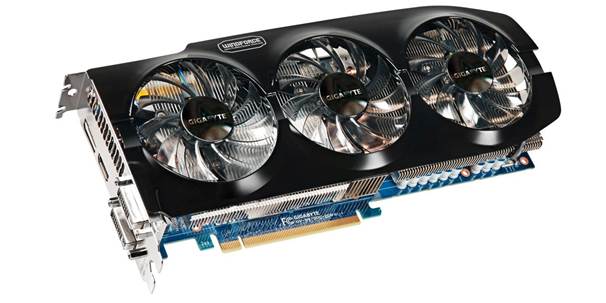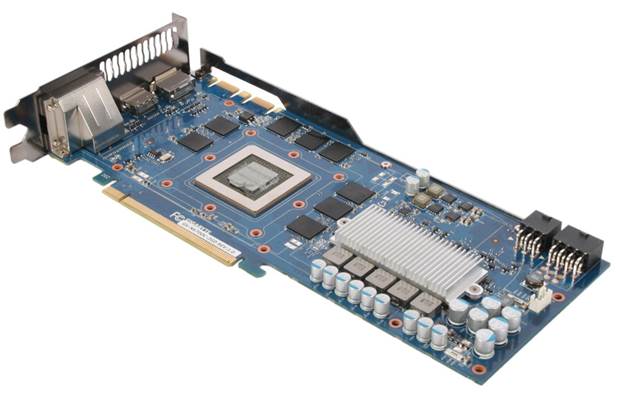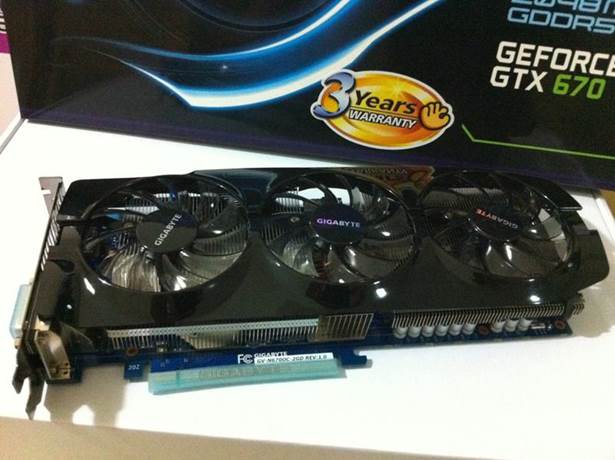Gigabyte overclocks the GTX 670 and straps a
custom cooler to it
NVidia's standard GeForce GTX 670 2GB is
one of the best cards on the market at the moment in terms of price versus
performance. Costing around $467, it offers performance close enough to that of
the GTX 680 2GB for it to not really be worth shelling out the extra cash for,
and it's cheaper (for now) than its closest rival from AMD, the $500 Radeon HD
7970 3GB.

Gigabyte
GeForce GTX 670 2GB Windforce 3X
Board partners like Gigabyte already have a
good starting point therefore, and are thus left with the task of keeping their
cards competitively priced while improving the reference design. Physically,
Gigabyte's GTX 670 2GB is closer to the stock GTX 680 2GB model because it uses
the same 257mm PCB of the latter card, only with a GTX 670 GPU connected. As a
reminder, the GTX 670 GPU is a 28nm Kepler architecture GPU, with a total of
1,344 stream processors and 112 texture units. It's normally clocked at 915MHz
(with a boost clock speed of 980MHz), but Gigabyte has applied a 7% overclock
to its card, taking the core clock speed up to 980MHz (1058MHz boost)

The
three fan cooler takes the dual-slot card's total length to 275mm, so it's
worth checking your case has room enough to house it before making a purchase.
Four 64-bit memory controllers provide a
256-bit memory interface, as well as 32 ROPs. They're connected to the 2GB of
GDDR5 memory, which Gigabyte has left at its stock frequency of 1.5GHz (6GHz
effective), thus providing a total of 192GB/s of memory bandwidth. As it
utilises the GTX 680 PCB, all the memory chips are found on the front of the
board, rather than split between the front and the rear as with the normal GTX
670 cards.
The three fan cooler takes the dual-slot
card's total length to 275mm, so it's worth checking your case has room enough
to house it before making a purchase. Connection wise, the card has two SLI
connectors and will require a single six-pin and another eight-pin PCIe power
connection from your PSU to run. The card supports up to six displays, and
outputs via two DVI ports, a HDMI connection and a single DisplayPort.
The card features five power phases that
provide the GPU's power, alongside two for the memory, for a total of 7+1 phase
power - one more than stock GTX 670 models. The VRMs supplying the GPU have
their own small heatsink, and the larger heatsink provides direct cooling to
the GPU and all of the memory chips. This is subsequently cooled by the three fans,
which thankfully stay whisper quiet during use and keep the card way cooler
than the original GTX 670. The cooler's only downside is that some of its hot
air is exhausted back into your case.
The overclocking potential of the card is
excellent, as I was able to push the core frequency to 1080MHz (1,159 boost),
which is 10% higher than its factory settings and 18% faster than reference
models of the GTX 670. The memory reached 1.85GHz (7.4GHz effective) before
becoming unstable, which is a massive 23% boost.

As
the 3DMark11 benchmarks show, the Gigabyte card puts in a great performance
As the 3DMark11 benchmarks show, the
Gigabyte card puts in a great performance. It trumps the equally priced Radeon
HD 7970 3GB, and in real-world performance it manages performance that is
almost equal to the GTX 680 2GB and the Radeon HD 7970 3GB GHz Edition, both of
which are significantly more expensive. It'll play games such as Battlefield 3
and Crysis 2 at 2560x1600 at the highest settings with smooth frame-rates, and
at overclocked settings the card will actually do so faster than the two
aforementioned costlier cards, which is fantastic.
Gigabyte's GTX 670 2GB does justice to the
original card by providing excellent performance for a reasonable price. For
high-resolution, high-detail gaming, this card is a brilliant choice, as it can
trump more expensive cards through some simple overclocking. Further, as the
custom cooler is wonderfully quiet and cool, it justifies the extra $32 the
card costs over standard GTX 670 models.
|
Details
·
Price: $500
·
Manufacturer: Gigabyte
·
Website: www.gigabyte.com
·
Required spec: Two free PCIe expansion slots,
eight-pin and six-pin PCIe power connections
·
Quality: 9
·
Value: 9
·
Overall: 9
|